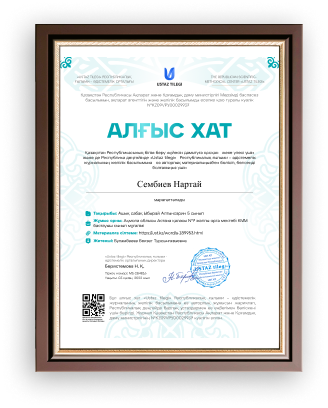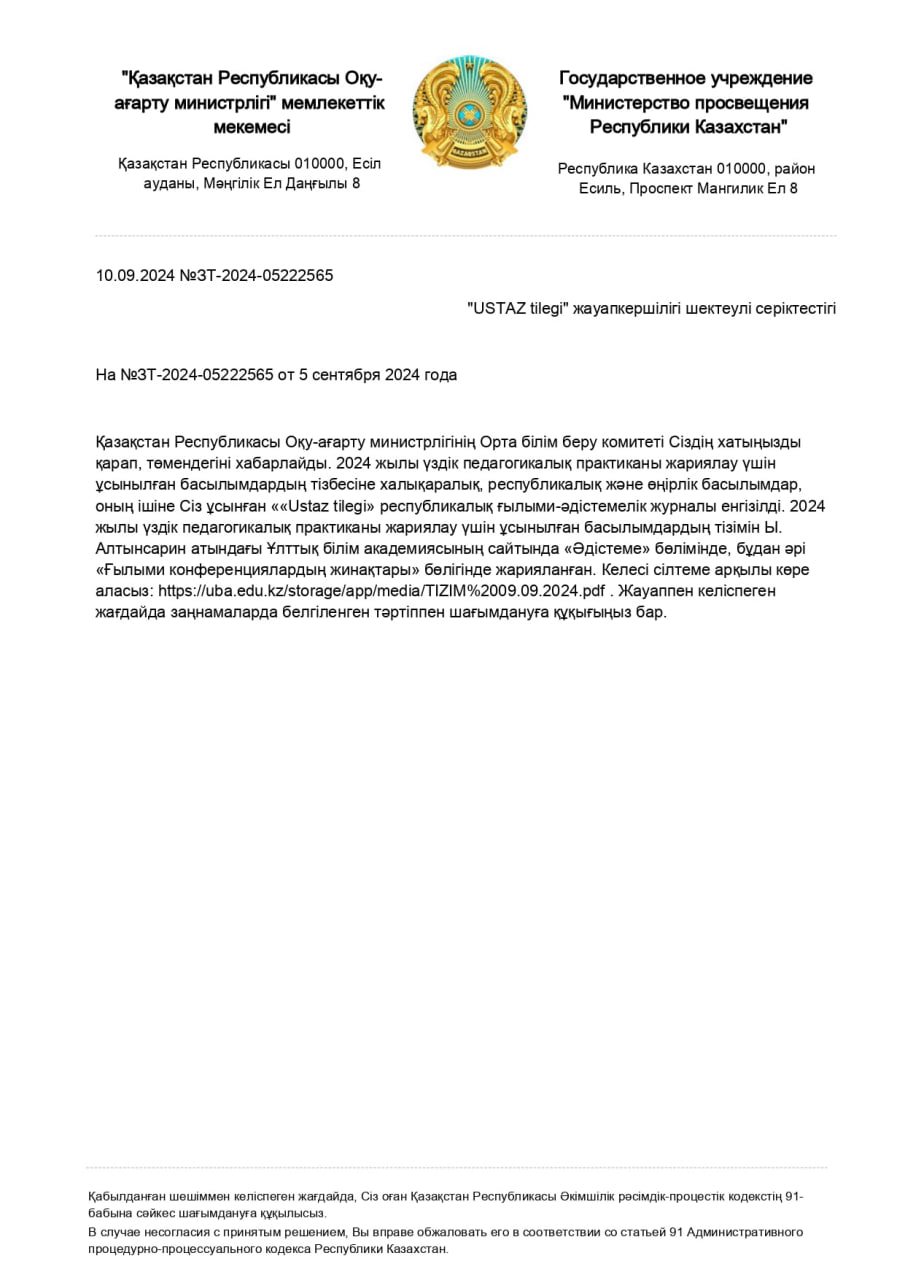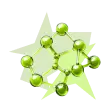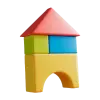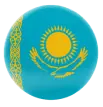|
Module
2. Values in Myths
and Legends
LESSON:
15
7. Theme: Dragons
and creatures 2
|
School:
|
|
Date:
|
Teacher’s name:
|
|
CLASS: 4
|
Number present:
|
absent:
|
|
Learning
objectives(s) that this lesson is contributing
to
|
4.2.4.1 respond to
questions on an increasing range of general and some curricular
topics;
4.2.6.1 take turns when
speaking with others in a growing range of short, basic
exchanges;
4.3.3.1 recognise basic
opinions in short, simple texts on an increasing range of general
range of general and some curricular topics;
4.4.3.1 write with
support short sentences which describe people, places and
objects;
4.5.12.1 use adverbs of
time and frequency: sometimes, often, always, never to indicate
when and how often, begin to use simple adverbs of manner example
given well, badly, use common -ly manner adverbs to describe
actions example given slowly, quickly;
4.5.15.1 use would you like
to to invite and use
appropriate responses yes please, no thanks, use let’s + verb,
verbs go enjoy like + verb + ing, begin use infinitive of purpose
to describe simple actions and verbs want, start + infinitive, use
declarative what [a/an] + adjective + noun to show
feelings
|
|
Lesson objectives
|
All learners will be able to:
respond to
questions on an increasing range of general and some curricular
topics
|
|
Most learners will be able to:
write with
support short sentences which describe people, places and
objects;
|
|
Some learners will be able to:
write with
support short sentences which describe people, places and objects;
use adverbs of time and frequency: sometimes, often, always, never
to indicate when and how often, begin to use simple adverbs of
manner example given well, badly, use common -ly manner adverbs to
describe actions example given slowly, quickly;
|
|
Assessment
criteria
|
To explore other
subject areas (Natural History)
To talk and write about dinosaurs.
|
|
Language
focus
|
Structures: plurals; -ing form;
conjunctions possessive case.
Language in
use: Dracorex was a dinosaur
that looked a lot like a dragon! The Kondo
Dragon is the largest
lizard in the world. What a strange creature! Would you like
to
see
it?
|
|
Target
vocabulary
|
Dragons and Creatures 1: horn, spike, tooth,
claw, tail, feather
|
|
Cross
- curricular
links
|
Natural
History
|
|
ICT
skills
|
Using videos& pictures, working with URLs
(Internet)
|
|
Plan
|
|
|
Part of the
lesson/Time
|
Teacher’s activity
|
Student’s activity
|
Assessment
|
Resources
|
|
Beginning
of the lesson
Warming-up
Team
work
3
min.
|
Organization
moment:
1.Greeting.
Ask about the
weather.
Prepare worksheets with
tasks and organize Ss places.
In differentiation part
«Refreshing» method was used to
encourage them to revise previous materials.
|
Prepare to write Check
point.
“T’s wish”method to
encourage Ss
The
aim: To develop Ss speaking
skills and create friendly atmosphere
Efficiency: By telling the
compliments they show their appreciations.
|
At
the organization moment T tries to award active
Ss. «The
praise» method is used to evaluate Ss with phrases
like:
“Good
job!
Well done!”
|
CD player
Microphone
cards
|
|
|
(An activity to revise
the language of the previous Lesson.)
Play the song from the
previous lesson. The pupils sing along.
Ask some pupils to present their portfolio activities from
the previous lesson
|
PRESENTATION AND
PRACTICE
(Activities to present
and activate the new language.)
Dragons and Creatures 1
POSTER
|
T praise active Ss with
phrases such as: “Good job!
Well done!” “One more time,
please”
|
Whiteboard
Pupils Book
|
|
|
26 Listen and read.
Then label the pictures with the words in
bold.
Pupils’ books
closed. Have a class
discussion, in L1 if necessary, about dinosaur. Put the Dinosaurs
poster up on the board. Say and point to the words, one at a time.
The pupils repeat, chorally or individually. Then point to the
pictures in random order. Ask individual pupils to name
them.
Pupils’ book
open. Play the CD. The pupils
listen and follow in their books. Explain the activity. The pupils
read the text silently and label the pictures. Allow them some time
to complete the activity. Check their answers.
|
Answer
key
2 spikes 3 teeth 4
feathers 5 tail 6 claws
Then individual pupils
read out the texts.
|
T praise active Ss with
phrases such as: “Good job!
Well done!” “One more time,
please”
|
Whiteboard
Pupils Book
|
|
|
27 read and
complete. Use: and, or, but,
because.
Read the instructions
and the example and explain the activity. Go through the sentences
and elicit\explain any unknown words. Allow the pupils some time to
complete the activity. Check their answers.
|
Answer
key
2 but 3 or/and 4 but 5
because
|
T praise active Ss with
phrases such as: “Good job!
Well done!” “One more time,
please”
|
Whiteboard
Pupils Book
|
|
|
28 Read, choose and
complete.
Read the instruction
and explain the activity. Go through the text and elicit/ explain
any unknown words. Allow the pupils some time to complete the
activity. Check their answers.
|
Answer
key
2 yellow 3 four 4 tail
5 teeth 6 visit
|
T praise active Ss with
phrases such as: “Good job!
Well done!” “One more time,
please”
|
Whiteboard
Pupils Book
|
|
|
29 Collect
information about another dinosaur. Make a project or a PowerPoint
presentation. Present it to the class.
Brainstorm ideas about
dinosaurs and write them on the board. Explain the activity. The
pupils use the Internet to find information about another dinosaur
and present it to the class. Tell them to use the text in ex.26 as
models. Alternatively, assign the project as homework. Then help
them file their projects in their Language
Portfolios.
Note lf the pupils do
not have internet access, ask them to use encyclopedias, newspapers
or magazines.
|
Suggested answer
key
Triceratops means `three-horned face. It was nine metres
long. It had a big head with three horns – two on its forehead that
could grow up to one metre in length, and a shorter one on its
nose. Triceratops looked scary but it only ate plants. What a
strange creature!
|
T praise active Ss with
phrases such as: “Good job!
Well done!” “One more time,
please”
|
Whiteboard
Pupils Book
|
|
|
(An activity to
consolidate the language of the lesson.)
Ask the pupils to write
two things that impressed them about each dinosaur. Ask individual
pupils to report back to the class.
Suggested answer
key
Dracorex looked like a
dragon! It was about 3 metres tall.
|
Deinonychus means
`terrible claw`. It had a long tail and its body was covered in
feathers.
ACTIVITY BOOK
(Optional)
If you wish, you can assign some or all of the
corresponding activities from the Activity Book for homework. If
this is the case, make sure you explain them first in
class.
|
T praise active Ss with
phrases such as: “Good job!
Well done!” “One more time,
please”
|
Whiteboard
Pupils Book
|
|
End of the
lesson.
Reflection
Individual
work:
5 min.
|
Traffic light method is
used to find out was the lesson clear or not.
Use the stickers.
|
Ss use their stickers
to show their knowledge according to the lesson
Green- I
understood
Yellow-I have some
questions
Red-I need a
help.
Aim: To know how many Ss got
the theme.
Efficiency:
Ss can use colors to
show how much do they remember.
Differentiation: «Conclusion» method is used to
finish the lesson.
|
Descriptor:
Know all the key words
of this unit.
Can use grammar
material
2points.
Ss evaluate
each other and encourage classmate with phrases
like:
Well done!
Brilliant! Good job! I like it!
|
Whiteboard
Pupils Book
Poster.
|

